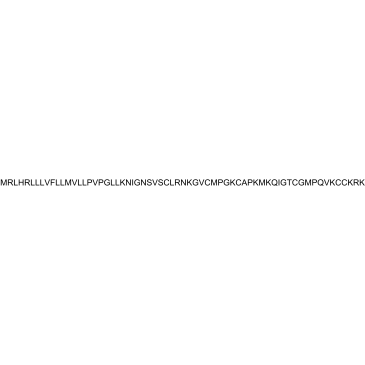pBD-1
Modify Date: 2025-08-25 17:08:11

pBD-1 structure
|
Common Name | pBD-1 | ||
|---|---|---|---|---|
| CAS Number | 206367-33-1 | Molecular Weight | 7065.98 | |
| Density | N/A | Boiling Point | N/A | |
| Molecular Formula | C310H543N91O73S11 | Melting Point | N/A | |
| MSDS | N/A | Flash Point | N/A | |
Use of pBD-1pBD-1 is an endogenous and constitutively expressed antimicrobial peptide (AMP) from porcine tissues, particularly expresses in pig mucosal epithelial sites. pBD-1 has antimicrobial activities and contributes to mucosal and systemic host defenses in pigs[1]. |
| Name | pBD-1 |
|---|
| Description | pBD-1 is an endogenous and constitutively expressed antimicrobial peptide (AMP) from porcine tissues, particularly expresses in pig mucosal epithelial sites. pBD-1 has antimicrobial activities and contributes to mucosal and systemic host defenses in pigs[1]. |
|---|---|
| Related Catalog | |
| Target |
IC50: bacterial[1] |
| In Vitro | In a northern blot analysis, pBD-1 mRNA only expresses in ongue epithelial tissues from 4-5 week old pigs[1]. In RT-PCR analysis, pBD-1 message throughout the epithelia of the respiratory (from nasal septum to lung) and gastrointestinal (from esophagus to rectum) tracts. In addition, it is detected in thymus, spleen, lymph node, brain, liver, kidney, urinary bladder, testis, skin, heart, muscle, bone marrow, alveolar macrophages, peripheral blood neutrophils and the umbilical cord. The only cells evaluated that does not express pBD-1 are peripheral blood mononuclear cells[1]. |
| References |
| Molecular Formula | C310H543N91O73S11 |
|---|---|
| Molecular Weight | 7065.98 |